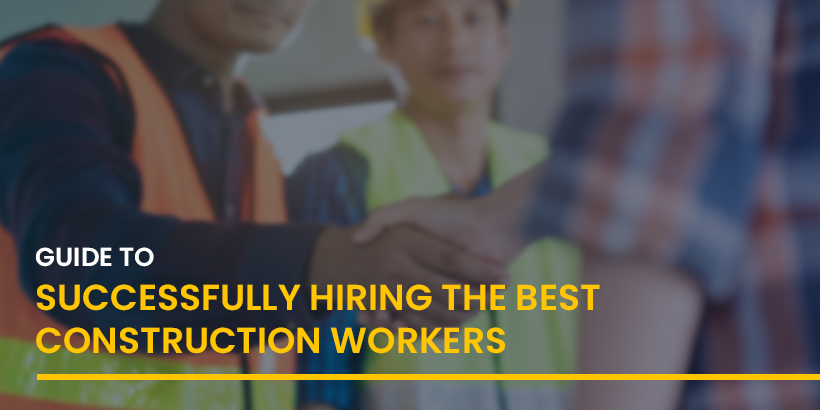
Even in 2022, no complete discussion around any industry’s current state can be made without acknowledging the pandemic’s impacts.
The global construction industry, like others, received a terrible blow in the last 2 years. A lot of construction projects across Canada, no matter the size and importance, were put on hold. Global supply chains were disrupted and work couldn’t maintain any continuity.
As a result of the same, the construction workforce suffered.
According to Deloitte, a combination of all the above factors led to a loss of 6.5 million
construction jobs across the globe. The global construction industry saw a GDP drop
worth more than 60 billion dollars.
Most of the older workforce retired, and younger job-seekers grew insecure and started viewing construction as an unstable career option.
As the world economy finally opens up, businesses are struggling to find suitable talent for various construction tasks.
If you are one of such employers, the way ahead for you is challenging.
To help you out, we have prepared a guide on how you can attract the best construction
labor amidst the current conditions of a raving economy, a huge skill gap, and a
shrinking workforce.
1) Have the Best Offers
We cannot stress this one enough. If you wish to get a huge edge over your competitors, you should be willing to provide the best possible value to job seekers. The best way to do the same is by offering the finest compensation packages.
A well-thought compensation policy will help you in creating happier workplaces, attracting top-tier talent, promoting employee retention, and improving the brand image of your company.
Here are a few notable offers that you can include in your compensation list:
- First & foremost, competitive salaries
- Suitable daily/ hourly wages, considerably above the minimum wage line
- Productivity and overtime bonuses at construction sites
- Well-being initiatives and aids
- Modern safety gears + first aid kits
- Safe-to-use toolkits and machinery
- Flexible work hours
- Shared job shifts
- More paid leaves
- Handwash & sanitization stations
- Retirement schemes
- Telehealth and mental health schemes
2) Realize the Changing Mindsets
Job expectations of the global workforce have changed a lot. The idea of an ideal workplace for different industries has undergone a transformation and the construction industry is no exception.
People have started realizing the importance of having an apt work-life balance.
Awareness regarding the importance of mental health is growing.
Due to the large number of layoffs that happened in recent years, a secure job has
become more important than a well-paying one.
As an employer, you need to adapt to these revised priorities. Conducting an in-depth analysis of the same will help you in taking a better stand as a job provider.
Along with offering a suitable compensation package (as discussed in the point above), another notable step that you should consider taking is the following: develop relevant career advancement opportunities.
Doing so will help you in removing the insecurities of an unstable career from your potential employee’s mind.
3) Narrowing the Skill Gap
With the increasing use of advanced machinery (based on ML and AI) in the construction workspace, the older workforce needs to be re-trained.
In order to make sure that your pool of employees doesn’t lack behind, you need to focus on 2 aspects.
The first one is setting a significant budget aside for developing in-house upskilling and reskilling programs.
Upskilling programs, as the name suggests, enable an employee to upgrade his/ her skill set level so as to access newer growth opportunities.
Reskilling, on the other hand, refers to acquiring newer skills that are more useful and in-demand in today’s world of automation.
An ideal approach here includes an initial skill assessment survey. This will help you in identifying a set of skills that are going to fit in with the future trends in the construction industry.
Along with this, you’ll also need to determine the level of the skillset that your current employees possess. Hence, you can move forward and give shape to your reskilling & upskilling programs.
Secondly, along with training your current pool of workers, you should also start focusing on getting better at the art of hiring correctly.
This includes creating detailed and befitting job descriptions, hunting for the ideal employee in the right places, interviewing with the right questions, assessing the candidate on multiple fronts, and having an apt onboarding process.
Conclusion
A combination of all the above gives shape to an ideal construction workplace in today’s time. Along with these, there are a few addons that will help you in creating an ideal brand image.
These include having proper DE&I policies in place, continuously striving to improve your employees’ work experience, keeping an eye on popular HR trends and incorporating the same into your workplace, showcasing happy employee testimonials, etc.
If you are a construction company that is currently aiming to untangle its hiring pipelines, we at M&M would be more than happy to help.
To help you make a clear decision, we have compiled the top benefits of outsourcing your recruiting process: Winning with M&M